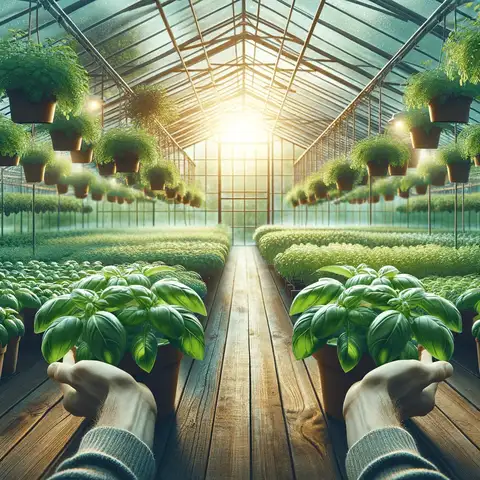Growing basil in a greenhouse! Basil is a super popular green leaf that smells great and tastes good. It can make things like pasta sauce and salads taste really good. There are different kinds of basil, too; some are green, and some are even purple!
Growing basil in a greenhouse is a smart idea. It’s like giving the plants their own special house to live in where they can be safe from rain, too much sun, or bugs that might eat them. Inside the greenhouse, basil can grow big and strong all year long, no matter what the weather is like outside.
We’re going to learn all about how to grow the best basil in a greenhouse. We’ll talk about what basil needs to grow up healthy, like the right kind of dirt and just enough water.
Setting Up – Growing Basil in a Greenhouse
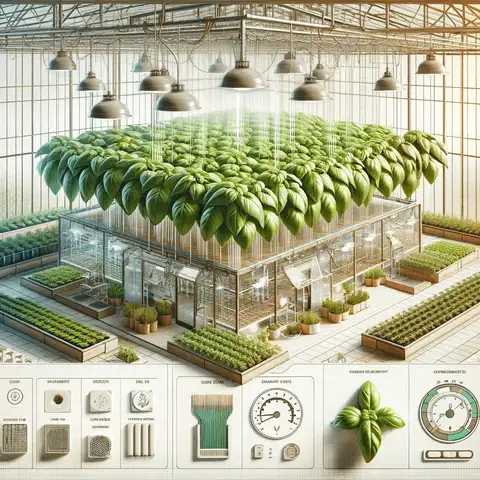
Basil loves warm air and a bit of sunshine, but not too much! To make basil happy in a greenhouse, you need to keep it warm but not hot. The air inside should be a little wet, but not too wet. You can use a thermometer to check the warmth and a tool that tells you how wet the air is, called a hygrometer.
Tools You Need to Grow Basil
Before you start planting basil in your greenhouse, you’ll need to gather some tools.
The Basic Tools for Planting Basil:
- Trowel: This is a small hand shovel that’s perfect for digging little holes for your basil seeds or seedlings. It fits right in your hand and makes planting easy.
- Watering Can: Basil plants need water just like we need to drink when we’re thirsty. A watering can with a long spout helps you give water to the basil without getting the leaves too wet, which they don’t like.
- Garden Gloves: Wearing gloves keeps your hands clean and safe when you work in the dirt. They can also protect you from anything sharp in the soil.
- Plant Markers: These are little signs you can put in the dirt to remember where you planted your basil and what type you planted.
- Pruners or Scissors: When your basil starts to grow, you’ll need something sharp to help you cut the leaves.
- Ruler or Measuring Tape: To make sure each basil plant has enough room to grow, you’ll use a ruler or measuring tape to space them out.
- Stakes or Plant Supports: Some types of basil can get tall and might need a stick (called a ‘stake’) to help them stand up straight.
Where to Put Your Basil Plants
Imagine if you had to share your bed with lots of people – you wouldn’t have much room to stretch, right? Basil plants feel the same way about their space.
Sunlight and Air:
Basil loves the sun but only a little. They like to get some shade, too. When you place them in the greenhouse, make sure they can get some gentle sunlight. When plants are too close together, they can’t breathe well, and that can make them sick.
Tall Friends Need More Room:
Some basil plants can get really tall. If you’re growing a tall variety, they might need a little more space so they can grow up without bumping into their neighbors.
Check on Them:
As your basil plants grow, check if they have enough room. You should move them a little bit to give them more space.
Growing Together:
Just like people, plants do well when they have their own space but are still close enough to be friends. When you give your basil plants the right amount of space, they’ll grow up healthy and give you lots of tasty leaves for your food.
How Much Space Does Each Plant Need?
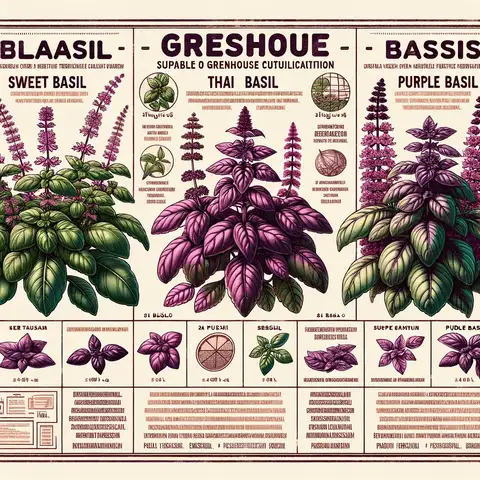
- Measure the Space: Use a ruler or a measuring tape to give each basil plant its area. You can think of it like each plant having its room in a house.
- The Perfect Spot: When you plant them, make sure there’s about the space of two hands (about 12 to 18 inches) between each plant. This gives the roots room to spread out and the leaves space to catch the sunlight.
- In a Row: Plant your basil in rows, and make sure there’s a walkway between rows so you can water and pick the leaves without stepping on any plants.
Soil Preparation and Planting
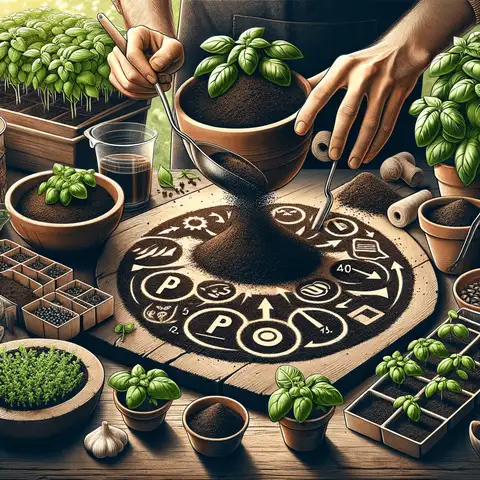
Basil isn’t picky, but it does like its home to be cozy. The dirt, or ‘soil,’ is like a bed for your basil plants. It should be soft and full of little bits of old leaves or bark, which is called ‘compost.’ The compost helps give food to the basil as it grows.
What’s pH and Why Does it Matter?
The ‘pH level’ of the soil is like a number that tells us if the dirt is more like a lemon or more like soap. Basil likes it right in the middle, not too lemony and not too soapy. You can get a test kit from a garden store to find out the pH of your soil. For basil, aim for a pH that’s around 6.0 to 7.5.
Starting Basil from Seeds or Cuttings
You can start growing basil in a greenhouse from tiny seeds or from a piece of another basil plant care, which is called a ‘cutting.’
From Seeds:
- Put the seeds on top of the soil and cover them with a tiny bit of dirt, no deeper than the seed is thick.
- Give them a gentle drink of water and keep the soil moist as they start to grow.
From Cuttings:
- Take a piece of basil that has a few leaves on it.
- Put the cut end into the water until it grows roots, which looks like little white strings.
- Once you see roots, you can plant the cutting in the soil.
How to Plant Your Basil
- Dig a Home: Use your trowel to make a little hole in the soil for each seed or cutting.
- Planting Seeds: Drop in a couple of seeds and sprinkle a little dirt over them, just enough to cover them up.
- Planting Cuttings: If you have a cutting, place the roots down into the hole and fill in around it with soil.
- Watering: Give your new plants a drink with your watering can. Make sure the water doesn’t puddle on top; it should soak into the dirt.
- Spacing: Remember to leave enough room between each plant for them to grow.
- Labeling: Use your plant markers to write down what kind of basil you planted and when you planted it. Stick the marker in the soil by the plant so you remember.
Waiting for Growth:
After you plant your seeds or cuttings, it will take a little time before you see the plants come up. Keep the soil moist and check on them every day.
Climate Control in the Greenhouse
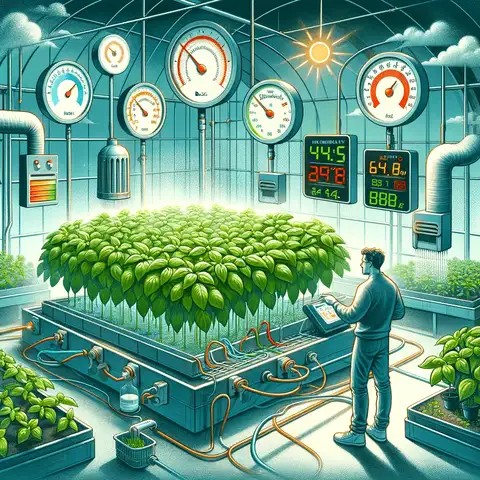
Basil plants are like people who enjoy warm, sunny days. They grow best when it’s not too hot or too cold. The best temperature is between 70°F and 80°F during the day. At night, it can be a little cooler, but not below 50°F. You can use a thermometer to check the temperature in your greenhouse to make sure it’s just right.
Humidity and Fresh Air for Healthy Basil
A good humidity level for basil is around 40% to 60%. If the air is dry, your basil might be happier. You can use a hygrometer (a tool that measures humidity) to see how moist the air is. Also, basil likes fresh air, so make sure your greenhouse has vents or windows that you can open to let in some breeze.
Sunlight: Not Too Much, Not Too Little
Basil loves sunlight, but not all day long. It likes to have some shade, too. In the greenhouse, you can control how much light your basil gets. If the sun is very bright, use a shade cloth to provide the basil some shade. Aim for about 6 to 8 hours of sunlight each day. This helps the basil grow strong and healthy without getting sunburned.
Watering and Feeding Your Basil Plants
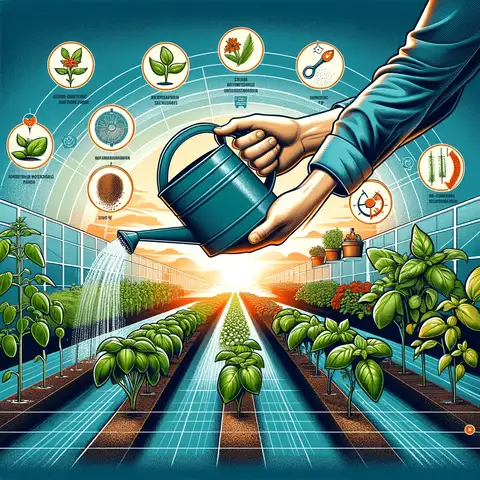
Basil likes to drink, but only a little. It’s like giving a pet enough water to be happy, but not so much that their bowl overflows.
The Best Way to Water Basil
Try to pour the water near the base of the plant, not on the leaves. This helps keep the leaves dry and healthy. A watering can with a long spout is perfect for this. Or, you can use a gentle spray bottle to mist the soil.
Food for Your Basil: Fertilizer
Just like we need food, basil needs nutrients to grow. Fertilizer is like plant food. Make sure it’s a kind that’s good for edible plants. Follow the instructions on the bottle to see how much to use.
Too Much or Too Little Water?
Sometimes, it’s hard to tell if you’re giving your basil too much or too little water. Here are some signs to look out for:
Overwatering:
- Leaves turn yellow or brown.
- The soil always looks wet.
- The plant might look droopy.
Underwatering:
- The soil is dry and crumbly.
- Leaves look wilted or dry.
- The plant stops growing.
Feeding Your Basil Right
By checking your basil every day and watching how it grows, you can tell if it’s happy with the amount of water and food it’s getting.
Pruning and Maintenance
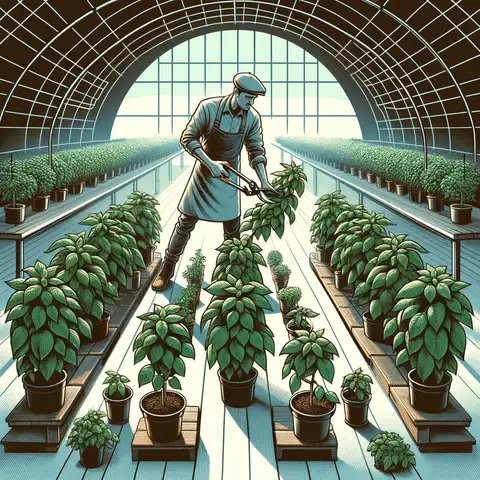
Pruning means cutting off some parts of the plant so it can grow better. For basil, pruning helps make the plant bushy with lots of leaves. It’s like getting a haircut to look neat!
When and How to Prune Basil
- Start When the Plant is Young: When your basil plant has about 6-8 leaves, it’s ready for its first trim.
- Cutting the Right Spot: Look for where tiny leaves are starting to grow on the stem. Cut right above those tiny leaves. Use clean scissors or pruners for this.
- Regular Trims: Every few weeks, give your basil another trim.
Keeping Your Basil from Getting Too Tall
If basil grows too tall, it might have fewer leaves. To keep it shorter and bushier:
- Trim the Top: Regularly trimming the top of the plant stops it from growing too tall.
- Pinch Off Flowers: If you see flowers starting to grow, pinch them off.
Routine Care for Your Basil
Here are some things to do regularly to keep your basil plants healthy:
- Check for Bugs: Sometimes, little bugs like to live on plants. If you see bugs, you can gently wash them off with water.
- Clean Dead Leaves: If you see leaves that are dead or yellow, take them off the plant.
- Check the Soil: Make sure the soil is moist but not too wet. Add water if it feels dry.
- Watch the Sunlight: Make sure your basil is getting the right amount of sun. Move it if needed.
Pest and Disease Management
Sometimes, little bugs or diseases can bother your basil plants. There are methods:
Common Pests That Love Basil
- Aphids: These tiny green or black bugs suck juice from the leaves. If you see them, you can spray your plants with water to clean them off.
- Spider Mites: These are super tiny bugs that make webs on plants. If the leaves look dusty or have tiny webs, spray them with water.
- Slugs and Snails: These slimy creatures chew holes in the leaves. You can pick them off by hand if you see them.
How to Keep Pests Away
- Healthy Plants: Healthy basil plants can fight off bugs better. Make sure they get enough water and food.
- Clean Your Greenhouse: Keeping your greenhouse clean helps prevent bugs.
- Check Your Plants: Look at your basil plants often. If you see bugs early, it’s easier to stop them.
Diseases That Can Affect Basil
- Fungal Diseases: Sometimes, if the leaves stay too wet, they can get sick with a fungus. This looks like dark spots on the leaves. To prevent this, don’t water the leaves, just the soil.
- Root Rot: If the soil is too wet, the roots can rot. Make sure the soil drains well and don’t overwater.
Organic Ways to Fight Pests and Diseases
- Neem Oil: This is a natural oil that can stop bugs and fungus. You can spray it on your basil leaves.
- Insecticidal Soap: This special soap kills bugs but is safe for plants. You can buy it or make your own.
Harvesting Basil
When your basil plant has big leaves, about as many as your fingers, it’s time to pick them. This means you can use these leaves to make food tasty.
When and How to Pick Basil
- Morning Time is Best: Pick the leaves in the morning. They are fresh and yummy, then.
- Be Gentle: Use your fingers to take off the leaves softly.
- Start from the Top: Begin picking from the top of the plant.
- Leave Some Leaves: Only pick some of the leaves. The plant needs some to keep growing.
More Leaves, More Fun
- Pick Often: If you pick leaves a lot, the plant grows even more.
- No Flowers, Please: If you see flowers, take them off. We want more leaves, not flowers.
Fresh Basil is the Best
- Use It Quick: Basil is super tasty when it’s fresh. Try to use it soon after picking.
- Clean Them Gently: If you need to wash the leaves, use cool water. Then, make them dry with a towel.
Storing Your Basil
- In a Glass of Water: Put the stem of basil in water, like a pretty flower.
- Keep in the Fridge: Wrap basil leaves in a wet paper towel. Then, put them in a bag in the fridge.
- Freeze for Later: You can freeze the leaves in a bag. Or put them in ice trays with water.
Advanced Techniques for Prolific Basil Growth
Basil doesn’t just grow in soil. Here is the technique:
- Hydroponic Basil Growing: This is a way to grow basil in water! The roots of the basil stay in water with special food for plants. This helps the basil grow big.
- Aeroponics: This is like growing basil in the air! The roots hang out and get sprayed with water and food. It’s like giving the roots a tiny rain shower.
Growing Basil All Year Round
- Keep it Warm: In your greenhouse, you can use heaters and lights to keep your basil warm. This way, you can have basil even when it’s cold outside.
- Pick Leaves a Lot: When you pick the leaves often, the plant grows even more!
Planting Friends: Companion Planting
- Planting Together: Basil likes to be near other plants, like tomatoes and lettuce. This is called ‘companion planting.’
- Keeping Bugs Away: Basil can help stop bugs from bothering other plants.
- Yummy Neighbors: Some people think basil makes other plants taste better!
Common Basil Growing Challenges
- Yellow Leaves: This might mean too much water or not enough food. Check the soil and adjust or fertilize.
- Droopy Plants: If your basil looks sad and droopy, it might require better water or a cooler place in the greenhouse.
- Spots on Leaves: Spots can be a sign of infection or bugs. Clear the bad leaves and ensure the plant has adequate airflow.
Adjusting Your Greenhouse
- Too Hot or Cold: Use fans, heaters, or open windows to keep the temperature just right.
- Not Enough Light: Move your plants to a spot where they get enough sunlight or use grow lights.
- Too Much or Little Humidity: Open or close vents and windows to control how wet the air is.
Expert Tips for Happy Basil Plants
- Regular Checks: Look at your plants every day. Catching problems is easier to fix.
- Clean Tools: Keep your gardening tools clean to stop diseases from spreading.
- Talk to Experts: If you need help with what’s wrong, ask someone who knows a lot about plants for help.
Beyond the Greenhouse: Using Your Basil
Using Fresh Basil in Food
After your basil grows, you can put it in tasty foods!
- In Salads: Rip the basil leaves and put them in salads. They make the salad taste fresh.
- On Pizza: Put basil leaves on pizza to make it yummier.
- In Pasta: Cut the basil and mix it into pasta sauce. It tastes great!
Keeping Basil for Later
Sometimes, you have too much basil. Here’s how to save it for later:
Drying Basil:
- Hang basil upside down in a place that’s warm and not wet.
- When it’s dry, break the leaves into small pieces and keep them in jars.
Freezing Basil:
- Put basil leaves in bags and put them in the freezer.
- You can also freeze them in ice trays with water or oil.
Making Pesto:
- Mix basil leaves with garlic, nuts, cheese, and oil to make pesto.
- Keep pesto in the fridge or freezer for later.
Selling Your Basil
If you have lots of basil, you can sell it!
- Fresh Basil: You can sell fresh basil to people at markets or to your friends.
- Basil Things: Make dried basil or pesto and sell them.
- Teaching About Basil: Show other people how to grow basil. You can sell a guide or have a class.
Now you know how to use your basil in food, save it for later, and even sell it!
Conclusion
We’ve learned a lot about growing basil in a greenhouse! Now it’s your turn to start growing basil.
FAQs
Q: How much water does basil need?
A: Water basil when the top inch of soil is dry. Be careful not to overwater!
Q: Can basil grow in winter?
A: Yes! With a greenhouse, you can control the temperature and light to grow basil, even in winter.
Q: What should I do if my basil starts to flower?
A: Pinch off the flowers. This helps the plant focus on growing more leaves.
Q: How long does it take for basil to grow?
A: Basil seeds usually sprout in about a week, and you can start harvesting in about 4-6 weeks.
Q: Can I grow different types of basil together?
A: Absolutely! Different types of basil can grow together and can even help each other.






